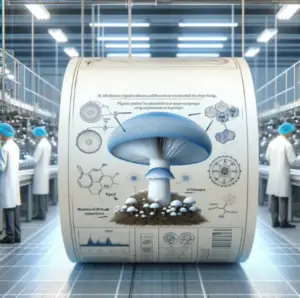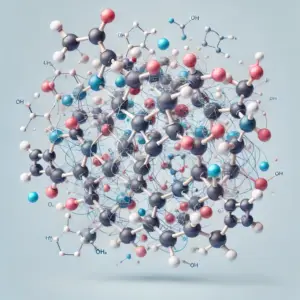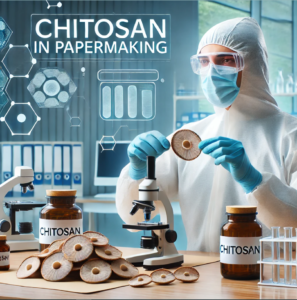


Did you say Mushroom Chitosan?
Mushroom chitosan is a natural biopolymer extracted from the cell walls of fungi. It comes from chitin, a structural component that gives mushrooms their rigidity and form.
Origin and Abundance
- Chitin is the second most abundant natural polysaccharide in nature, after cellulose.
- Most fungi contain 5%-7% chitin in their cell walls.
- Chitin is also found in the exoskeletons of crustaceans (crabs, shrimp, lobsters) and insects.
Pronunciation Guide
- Chitin: Pronounced “KITE-in” (emphasis on “kite”)
- Deacetylation: Pronounced “dee-a-SETTLE-ay-shun” (emphasis on “dee”)
- Acetyl: Pronounced “A-see-tl” (emphasis on “see”)
- Chitosan: Pronounced Kite-O-San, (emphasis on “Kite”)
Chemical Structure and Properties
Chitosan is obtained through a process called deacetylation of chitin. This involves:
- Removing acetyl groups (CH3OH) from the chitin molecule
- Creating a polymer with free amine groups (NH2)
This chemical transformation gives chitosan its positive charge, differentiating it from its parent compound, chitin.
- Solubility: Unlike chitin, chitosan is soluble in acidic to neutral solutions, making it more versatile for various applications. Our food-grade mushroom chitosan oligosaccharide is soluble in water at any pH. It is bactericidal at pH 6.4 and below. To purchase wholesale, click HERE
- Biocompatibility and Biodegradability: Chitosan is known for its excellent biocompatibility and biodegradability. It’s non-toxic and can be broken down by natural biological processes.
Medical and Pharmaceutical Innovations
Chitosan’s biocompatibility has revolutionized healthcare applications. Its use spans:
- Wound healing products
- Advanced drug delivery systems
- Tissue engineering biomaterials
The compound’s ability to accelerate healing and regulate drug release has solidified its position in the pharmaceutical industry. 1
Environmental Remediation
In the realm of water treatment, chitosan excels due to its affinity for:
- Heavy metals
- Various contaminants
This characteristic has led to its adoption in both industrial and municipal water purification facilities, contributing to cleaner water resources.
Agricultural Advancements
Farmers and agricultural experts harness chitosan’s potential as:
- A natural biostimulant
- A pathogen resistance elicitor
These properties foster more sustainable farming practices by enhancing crop growth and resilience.
Food Technology
In food production and preservation, chitosan serves multiple roles:
- Antimicrobial food additive
- Base material for edible films and coatings
These applications significantly extend the shelf life of perishable goods, reducing food waste.
Beverage Industry Applications
Chitosan plays a crucial role in alcoholic beverage production, particularly in:
- Wine clarification
- Beer and whiskey refinement
Its use enhances the clarity and stability of these products, improving their overall quality.
Nutritional Supplements
The compound has found its way into the dietary supplement market, leveraging its potential health benefits to create new product lines.
Sustainable Materials Development
In the plastics industry, chitosan’s biodegradable nature positions it as a promising candidate for developing eco-friendly alternatives to conventional plastics, aligning with global sustainability goals. Through these diverse applications, chitosan continues to demonstrate its significance as a versatile and sustainable resource across multiple industries.

The wide-ranging applications of chitosan stem from its unique combination of biocompatibility, biodegradability, non-toxicity and positive charge.
Mushroom Chitosan is a type of chitosan derived from the cell walls of fungi. It has several advantages over traditional chitosan derived from shellfish, including:
- 1. Vegan and vegetarian-friendly: Mushroom chitosan is an excellent alternative for individuals who avoid animal-based products, such as those who follow a vegan lifestyle.
- 2. Allergen-free: Traditional chitosan is derived from shellfish, which can cause allergic reactions in some people. Mushroom chitosan does not contain any shellfish-derived ingredients, making it an allergen-free option.
- 3. Purer: Mushroom chitosan is often considered to be purer than traditional chitosan because it is derived from a single source, whereas traditional chitosan can be contaminated with other shellfish-related substances.
- 4. Better solubility: Mushroom chitosan is more soluble than traditional chitosan, which makes it easier to incorporate into a variety of applications such as cosmetics, bioplastics, wound care and food.
- 5. Improved bioavailability: Some studies have suggested that mushroom chitosan has higher bioavailability compared to traditional chitosan, which means that it can be absorbed and utilized more effectively by the body.

Overall, mushroom chitosan offers several advantages over traditional chitosan, making it an attractive alternative for individuals and industries looking for a vegan, allergen-free, and more effective chitosan source.
What are the Benefits of Chitosan in the Paper Industry?
Fungal chitosan, sourced from non-animal origins such as mycelium and mushrooms, is revolutionizing the paper industry by offering an eco-friendly alternative to traditional chemicals. Here are the benefits and functions of chitosan in paper industry:
Benefits of Chitosan in the Paper Industry
- Enhanced Strength: Chitosan improves the tensile and burst strength of paper, making it more durable for various applications, including packaging and specialty papers.

- Biodegradability: As a natural biopolymer, chitosan makes paper products more environmentally friendly by enhancing their biocompatibility and biodegradability. This feature is particularly important in reducing waste and promoting sustainability in paper production.

- Antimicrobial Properties: Chitosan has inherent antimicrobial properties due to its high positive charge when highly deacetylated. That can be beneficial in paper products that require sterility, such as medical packaging and food wrapping, helping to prevent the growth of bacteria and fungi.

- Improved Printability: The use of chitosan enhances the printability of paper by improving ink absorption and adhesion, resulting in much higher quality printed products.

- Waste Water Treatment: Chitosan has been proven effective in water purification processes used in the paper industry, helping to remove heavy metals and other pollutants from wastewater before it is released into the environment. 2

Chitosan as a paper strengthening agent in the paper industry:
- Fiber Bonding Enhancement:
- Chitosan improves the bonding between paper fibers, leading to increased mechanical strength of the paper.
- The positively charged amino groups in chitosan interact with the negatively charged surfaces of cellulose fibers, creating electrostatic bonding.
- Mechanical Properties Improvement:
- Addition of chitosan can significantly improve tensile strength, burst strength, and tear resistance of paper.
- For example, one study found that chitosan increased the tensile index, tearing index, and burst index of paper by 71.5%, 31.7%, and 79.1% respectively at a 3.0 g/m2 coating weight.
- Wet Strength Enhancement:
- Chitosan notably improves the wet strength of paper, which is crucial for many applications.
- One study reported that chitosan coating increased the wet strength of paper by 4.4 to 6.5 times compared to untreated paper.
- Flexibility Improvement:
- Chitosan can enhance the flexibility of paper, making it less brittle and more suitable for various applications.
- Additive Versatility:
- Chitosan can be used as both a wet-end additive and a surface coating agent in papermaking.
- As a wet-end additive, it can be mixed directly with the pulp before sheet formation.
- As a coating, it can be applied to the surface of formed paper sheets.
- Concentration Effects:
- The strengthening effects of chitosan are typically observed at relatively low concentrations, often in the range of 1-5% by weight.
- Synergistic Effects:
- Chitosan can be combined with other additives like nanofibrillated cellulose (NFC) to further enhance paper properties.
- Environmental Benefits:
- As a biodegradable and renewable material, chitosan aligns with the paper industry’s sustainability goals.

- Retention Aid: It helps in improving the retention of fine particles and fillers during the papermaking process. This leads to better efficiency and reduced costs by minimizing waste of raw materials.

- Sizing Agent: Chitosan can be used as a sizing agent to improve the water resistance of paper. This is particularly useful in making paper suitable for various printing and packaging applications where moisture resistance is necessary.

- Flocculant: In wastewater treatment processes within the paper mills, chitosan acts as a flocculant, aiding in the aggregation and removal of suspended solids, which clarifies the water and enhances the effectiveness of the wastewater treatment system.

- Antimicrobial Agent: Exploiting its antimicrobial properties, chitosan is used in papers that require a sterile environment, providing an inhibitory surface against microbial growth, thus extending the shelf life and usability of paper products in sensitive applications.

What are the common forms of vegetal chitosan in paper industry?
In the paper industry, vegetal chitosan, derived from sources like mushrooms, fungi, or other non-animal origins, is typically utilized in a few common forms to suit various applications.
The addition ratio of chitosan in paper production can vary widely depending on the desired properties of the final product and the specific form of chitosan used. Here’s a general guide on how each form is typically used and its suitable applications:
- Powder: Chitosan powder is the most common form used in the paper industry. It is easily dispersed in water and can be directly applied during the paper manufacturing process. The powder form allows for precise dosage and consistent distribution throughout the paper pulp.
- Adding Ratio: Typically, 0.5% to 3% of the dry paper pulp weight.
- Suitable Applications: Used across a wide range of paper products, including printing and writing papers where strength and durability are needed. It is also used in specialty papers like antibacterial or food contact papers.

- Flakes: Similar to powder, chitosan flakes are another dry form of chitosan that can be used in paper production. Flakes might require additional processing, such as dissolution in acidic solutions, before they can be integrated into the paper pulp.
- Adding Ratio: Similar to powder, around 0.5% to 3% of the dry pulp.
- Suitable Applications: Flakes are used similarly to powder but might require additional preparation steps. They are suitable for applications where gradual release of chitosan is beneficial, such as in filter papers or papers requiring slow antimicrobial activity.

- Solution: Chitosan is often sold in a liquid solution form, which can be directly added to the paper pulp or used in the paper coating processes. This form is particularly useful for applications requiring a more homogeneous integration of chitosan, such as in coating or surface treatment applications.
- Adding Ratio: Varies more significantly based on the concentration of the solution; commonly, solutions are used at 1% to 5% by weight of the paper.
- Suitable Applications: Solutions are particularly useful for coating applications where a uniform layer of chitosan is needed to enhance surface properties like printability, water resistance, or antimicrobial effects. It’s also used in paper sizing to improve resistance to liquid penetration.

- Gel: In some specific applications, chitosan gel might be used for its thicker, more viscous properties, which can be beneficial in coating or adding specific functional layers to the paper.
- Adding Ratio: Typically used in smaller amounts, around 0.1% to 1%, due to its high viscosity and concentrated form.
- Suitable Applications: Chitosan gel is often used for high-end specialty applications, such as medical papers or cosmetic pads, where a thicker, protective layer of chitosan is needed.

These forms are chosen based on their ease of integration into the paper manufacturing process and the specific functional properties they impart to the finished paper product.
These ratios and applications can vary based on the specific characteristics of the chitosan being used, the manufacturing process of the paper, and the properties required in the final product. Optimization and trials are usually necessary to determine the most effective usage rates and methods for incorporating chitosan into paper products.
Which type of chitosan is suitable for different elements in the paper industry?
Choosing the appropriate type of chitosan for different forms in paper production involves considering the solubility, molecular weight, and derivative characteristics of each type. Here’s a breakdown of which types of chitosan are suitable for each form:
- Acid-Soluble Chitosan (viscosity range of 20-1000 cps):
- Form: Powder, Flake, Solution, Gel
- Suitable Applications: This type is versatile due to its range of viscosities, making it ideal for both direct incorporation into the paper pulp as a powder or flake and for use in solution form as a coating or additive. High viscosity can also be used in Gels for paper-making production. It’s particularly useful where varying viscosity levels are needed for different processing or product requirements.
- Chitosan Hydrochloride:
- Form: Powder, Solution
- Suitable Applications: Chitosan hydrochloride is highly soluble in water, making it excellent for solution applications where a clear, consistent application is necessary, such as in surface sizing or coating. It can also be used in powder or flake form for direct pulp addition, enhancing paper’s antimicrobial and strength properties.
- Chitosan Oligosaccharide:
- Form: Solution, Gel
- Suitable Applications: With its low molecular weight and high solubility, chitosan oligosaccharide is ideal for use in solutions and gels where rapid bioactivity and high penetration into paper fibers are required. It’s particularly effective for enhancing the paper’s antimicrobial properties and in medical or food-grade papers where safety and sterility are paramount.
- Carboxymethyl Chitosan:
- Form: Powder, Solution, Gel
- Suitable Applications: This derivative of chitosan is more soluble in water than regular chitosan and has enhanced chemical stability, making it suitable for use in a variety of forms including solutions and gels. It’s particularly useful for paper products that require improved moisture resistance and stability under various pH conditions.
Each type of chitosan brings unique properties that can be leveraged for specific functional enhancements in paper products. The choice of chitosan type and form will depend on the specific requirements of the paper-making process and the desired properties of the final product.
The flowchart below depicts a methodical approach to converting aspergillus mycelium into various forms of chitosan, focusing on the purification and chemical modification steps necessary to achieve different chitosan-based products for use in various applications.

7. Discussion of Chitosan in the Paper Industry
Chitosan, sourced from non-animal origins such as mycelium and mushrooms, is revolutionizing the paper industry by offering an eco-friendly alternative to traditional chemicals.
As a natural biopolymer, chitosan is highly valued for its impressive array of properties which include enhanced paper strength, biodegradability, and inherent antimicrobial characteristics.
This makes it particularly suitable for applications ranging from food packaging, where safety and hygiene are paramount, to high-quality printing papers demanding superior ink adherence and durability.
The versatility of fungal chitosan allows it to be incorporated in various forms such as powder, flakes, solution, and gel, each tailored to meet specific industry needs.

Its use in paper products not only improves physical attributes like tensile strength and water resistance but also imparts environmental benefits by promoting the production of biodegradable and recyclable paper materials.
Moreover, the application of chitosan in paper manufacturing processes helps in wastewater management, effectively reducing pollutants and enhancing the sustainability of the paper industry.
By integrating chitosan into their operations, paper manufacturers can achieve balance between exceptional product quality and environmental stewardship, positioning their industry at the forefront of sustainable innovation.
References:
- https://www.mdpi.com/1420-3049/28/4/1963 Chitosan-Based Nanoparticles as Effective Drug Delivery Systems—A review
- https://www.ncbi.nlm.nih.gov/pmc/articles/PMC6415250/ Application of Chitin/Chitosan and Their Derivatives in the Papermaking Industry
Book a Free Consultation
If you don’t know what type of chitosan is best for your situation, Book an appointment. we will offer you an initial 30-minute consultation and product quotation at no charge.
